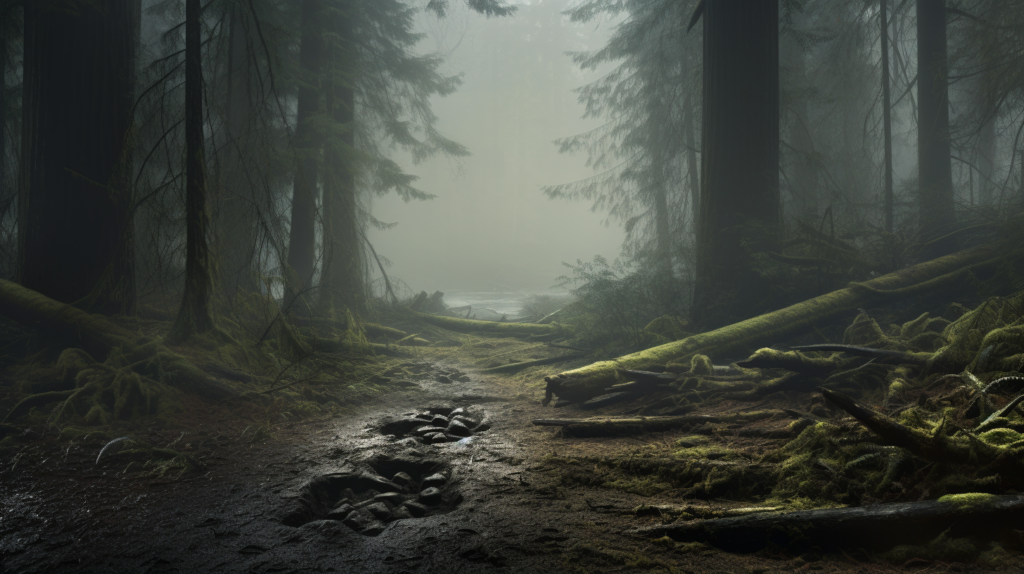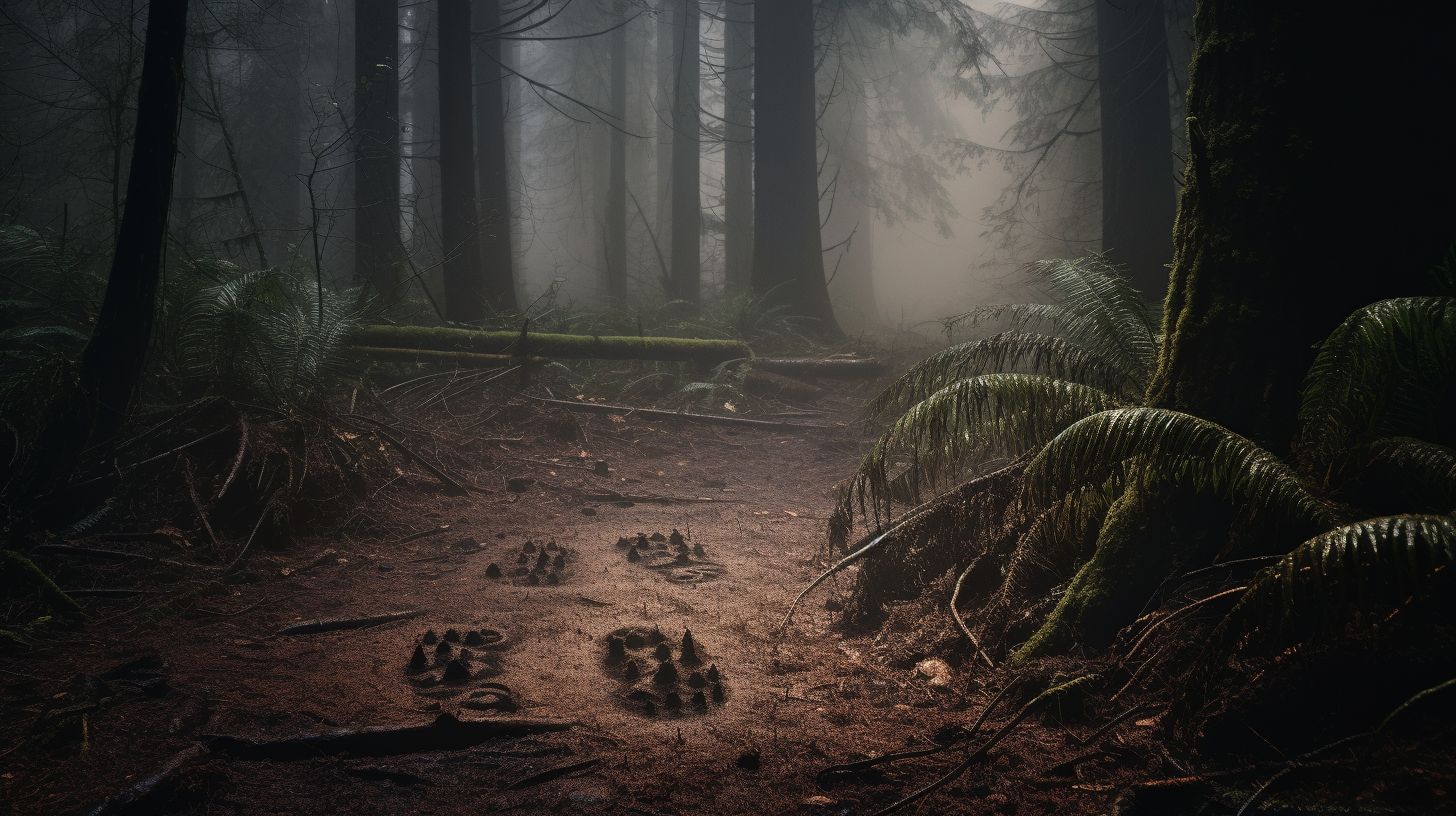In the vast forests of North America, the legend of Bigfoot, also known as Sasquatch, has captured the imaginations of many.
Described as a large, hairy creature standing at an impressive height, Bigfoot has been a subject of fascination and speculation.
Sightings of this elusive being have spurred countless debates and investigations into its existence. Central to this intrigue are the sizable footprints it is said to leave behind, a physical clue that has fueled both scientific interest and folklore.
The dimensions of Bigfoot’s feet have been a key focus for both believers and skeptics. Reports and castings suggest feet that are much larger than those of an average human, often described as being up to 24 inches long and 8 inches wide.
These measurements come from plaster casts of footprints purportedly found in the wilderness where Bigfoot is claimed to roam. The size of these footprints suggests a creature of significant stature and weight, adding to the air of mystery surrounding these alleged sightings.
What these tracks potentially indicate about the creature’s biology, habitat, and behavior continues to be a topic of discussion among enthusiasts and researchers.
Some interpret these large footprints as evidence of a creature well-adapted to life in the dense, remote forests of the Pacific Northwest, possibly requiring such sizable feet for stability and locomotion in an environment full of obstacles.
These footprints and sightings have contributed to sustaining the legend of Bigfoot as an enduring topic within popular culture and pseudoscientific study.
Historical Context and Sightings
Exploring Bigfoot’s footprints takes us through a rich tapestry of folklore and numerous accounts of encounters, where each step reveals different aspects of belief and skepticism.
Folklore and Native American Roots
Bigfoot, often viewed through the lens of Native American culture, is more than just a creature of myth; it represents a deep-rooted figure in the narratives of many tribes. The Salish refer to it as ‘Se’sxac’, meaning ‘wild man’. Tales describe a large, hairy being, akin to the “hairy man” figures found in legends across various cultures. These stories provide an essential perspective on Bigfoot’s place in North American natural history, reflecting a longtime awareness of such creatures.
Famous Encounters and Evidence
One of the most pivotal moments in Bigfoot lore is the Patterson-Gimlin film from 1967, captured near Bluff Creek, California. Roger Patterson and Robert Gimlin claimed to have filmed a Bigfoot, creating a short piece of footage that has stirred debate for decades. Despite numerous examinations, their footage remains a contentious piece of potential evidence.
Another significant find includes the Skookum Cast, an imprint said to be of Bigfoot’s body, though, like the Patterson-Gimlin film, it also faces scrutiny.
Hoaxes and Misinformation
Amidst genuine curiosity and investigation, the Bigfoot phenomenon has been riddled with hoaxes. Ray Wallace was a notorious figure whose claims of evidence were later revealed to be hoaxes, which he executed for notoriety. Critics like Benjamin Radford of Skeptical Inquirer have spent substantial efforts debunking such false claims.
These instances of misinformation have not only created setbacks for serious researchers but have also influenced the public perception of the Bigfoot legend.
Physical Characteristics and Evidence
The quest to understand Bigfoot has largely centered around the examination of physical evidence like footprints and hair samples, along with analyses conducted by scientific bodies.
Footprints and Physical Traces
Bigfoot is arguably most commonly known for his sizeable footprints. Cases such as the Skookum Cast, an imprint of the alleged creature’s body, provide some of the most compelling physical traces.
The Bigfoot Field Researchers Organization (BFRO) frequently collects footprints believed to be from Bigfoot, which show distinctive characteristics hinting at a human-like but larger and broader structure.
Descriptive Accounts from Eyewitnesses
Eyewitness accounts attest to Bigfoot’s human-like appearance, often describing it as a tall, hairy creature. These accounts, while anecdotal, have been consistently reported across different locations.
Peter Byrne, one of the most revered Bigfoot researchers, has collected numerous such eyewitness reports that describe a creature with physical proportions exceeding that of an average human being.
Scientific Analysis and DNA Evidence
While conclusive DNA evidence of Bigfoot remains elusive, there have been attempts at genetic analysis of purported hair and tissue samples.
Idaho State University, for example, has shown interest in research related to Bigfoot, looking to apply rigorous scientific study to understand the phenomenon. Meanwhile, various scientists work to examine genetic material that is alleged to come from Bigfoot, often finding the samples to pertain to known wildlife, though the mystery persists as data scientists continue to seek verifiable evidence.
The Ecosystem and Habitat

Exploring the supposed habitat of Bigfoot, one finds a connection with densely wooded areas, often in the Pacific Northwest. This section delves into the specific surroundings and potential lifestyle of such an elusive creature.
Bigfoot’s Natural Environment
Bigfoot, also known as Sasquatch, is said to inhabit vast, dense forests with a particular concentration of sightings in the Pacific Northwest and Northern California. These regions are typified by their old-growth forests, which offer abundant cover and food sources.
The Gifford Pinchot National Forest in Washington State is an example of the type of rugged, remote woodland area often associated with Bigfoot reports. These environments provide the seclusion and resources a large, bipedal creature would require to survive unnoticed.
- Terrain: Mostly dense, coniferous forests with a mix of deciduous groves.
- Climate: Mild, humid summers and cold, wet winters typical of the Pacific Northwest.
Diet and Behavior Patterns
The diet of Bigfoot, as hypothesized from reported sightings and evidence, suggests they are omnivorous, consuming easily accessible plant-based foods as well as meat. Sightings and supposed evidence often point to a diet that includes:
- Plants: Berries, fruits, and nuts native to the Pacific Northwest.
- Animals: Deer and other small to medium-sized game.
Given the resources available in its purported habitats, such as the abundance of berries and deer in regions like the Gifford Pinchot National Forest, one could surmise that Bigfoot subsists on a diet rich in both plant material and protein. Their bipedal movement pattern suggests an ability to travel over diverse terrains, potentially aiding in their foraging behavior.
Culture and Continuing Fascination
Bigfoot’s feet have not only left impressions on the ground but also on our culture, with a presence that extends from pop culture to dedicated research organizations.
Pop Culture and Media Presence
Bigfoot has firmly planted its oversized feet in pop culture, inspiring everything from movies and books to games and themed merchandise. The creature’s elusive nature and mysterious lore capture imaginations, featuring in children’s films such as “The Son of Bigfoot” and “Smallfoot”.
On YouTube, videos about Bigfoot attract millions, showcasing alleged sightings and analysis. Television hasn’t remained untouched, with shows like Expedition Bigfoot thrilling audiences with the possibility of new evidence and encounters.
Ongoing Research and Enthusiast Organizations
The search for Bigfoot is not just a hobby; for some, it’s a serious scientific pursuit. Organizations like the Bigfoot Field Researchers Organization (BFRO) compile sightings and conduct expeditions to gather evidence.
This study falls under the discipline of cryptozoology, which, although not recognized by mainstream science, has a dedicated following. Researchers and enthusiasts alike turn to platforms like YouTube to disseminate findings, debate theories, and share the latest news from expeditions like those seen on Expedition Bigfoot.
Their continuing efforts maintain public interest and contribute to the lore surrounding this iconic figure.
Frequently Asked Questions
In the quest to understand the enigmatic creature known as Bigfoot, their footprints have provided valuable clues. These frequently asked questions explore the size and characteristics of Bigfoot footprints and what they reveal about the creature.
What is the average size of a Bigfoot footprint?
The average Bigfoot footprint measures about 13 to 17 inches long. Bigfoot is said to have very big feet, a characteristic that has contributed to its name.
Can we determine a Bigfoot’s height from its footprints?
Research suggests that a Bigfoot’s height can be estimated from its footprints, and they are typically believed to stand between 7 to 9 feet tall based on the size of their tracks.
What is the difference between a Bigfoot footprint and a human footprint?
A Bigfoot footprint is much larger than a human footprint and typically shows a deeper imprint, indicating the creature’s substantial weight. Unlike human feet, Bigfoot tracks may also lack an arch and show wider toes.
How can you tell a real Bigfoot footprint from a fake?
Experts assess the depth, consistency, and patterns of erosion in a footprint to distinguish real from fake. Real tracks may have dermal ridges similar to fingerprints, which are difficult to fabricate.
What materials are used to make a Bigfoot foot mold?
Investigators usually use plaster of Paris to create casts of Bigfoot footprints. The plaster provides a durable and detailed mold that captures the texture and shape of the track.
Are there any scientific studies on Bigfoot footprints?
Yes, there have been scientific studies on Bigfoot footprints. While some analyses suggest that the prints could belong to known wildlife like bears, others examine the possibility of an unknown primate species based on unique foot anatomy.

